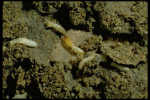Bugging out? Warm winter could mean lots more insects this spring and summer.

Between Terry Truitt and his father-in-law, the two pest control technicians have about 80 years worth of experience getting rid of pesky insects and bugs.
Extermination is a year-round job with no let up, even during the winter. But Truitt, an employee with Ashcraft Pest Control in Fort Scott, said the warm winter has made February the busiest month yet for him.
"The warm weather extends their breeding season," Truitt said.

Insects usually have a breeding period of around eight months, but the warm weather has extended the season to almost 12 months, Truitt said.
Experts say people may notice an increase in the bug populations this spring.
Wayne Bailey, an extension entomologist with the University of Missouri, said what "we'd like to see for maximum mortality" is for the weather to go from extreme heat to extreme cold a few times throughout the course of the winter.

"Most insects have a sugar-based antifreeze, if you will, that keeps them throughout the winter," Bailey said.
That natural, internal insulation in the insect breaks down with warmer weather which is why cyclical weather is needed.
"Without the extreme cold, they're not dying off," Bailey said.
People throughout the Midwest and most of the country have experienced uncharacteristic weather for the season.
With days in January and February reaching the upper 60s and 70s, areas are seeing departures from normal temperatures ranging in the double digits. On Jan. 30, Joplin, Mo., experienced temperatures 20 degrees above those recorded for that same day last year.
Bailey said this warmer weather causes insects to emerge sooner than normal.
"They're coming out pretty early this year," Bailey said. "Probably about two to three weeks early. Most of the time we're in April before we really see any high numbers."
Insects that might have increased populations this season are: spiders, ticks, chiggers, termites and worms.
"There are a lot of spiders right now," Bailey said. "I'm surprised to see how many spiders are out and about."
Bailey said the main concern this season, though, may be cutworms that are migrating from the Southern states.
But many variables factor into the insect increase, not just the warmer weather, some experts say,
Greg Chrislip, an entomologist with the state of Kansas, said natural predators and parasites also affect bug populations.
"It's hard to say (what insects might have increased populations) because you can't predict what kind of bugs might have other factors affecting them," Chrislip said.
And some pest technicians don't think the weather has or will affect populations any, if at all.
An employee with Alert One Termite and Pest Control in Fort Scott who asked that his name not be used, said he doesn't think Alert One has seen an increase in business or that it will have one this spring.
If it does prove true, in addition to the the increase in bothersome bugs, experts say there will also be an increase in beneficial critters.
Whether the bugs annoy or help, the federal Centers for Disease Control and Prevention warns of the potential risks associated with insects such as West Nile Virus, Lyme disease and Rocky Mountain spotted fever. The CDC website suggests using an effective insect repellent on skin and clothing, wearing long sleeves and long pants when possible, maintaining yards to get rid of standing water where mosquitoes lay their eggs, and reducing brush, tall grasses, leaf litter, and "harborage where ticks may like to hang out."
Bailey said people just need to "be wary of what's flying around."
"In general though, we'll be alright," he said.
